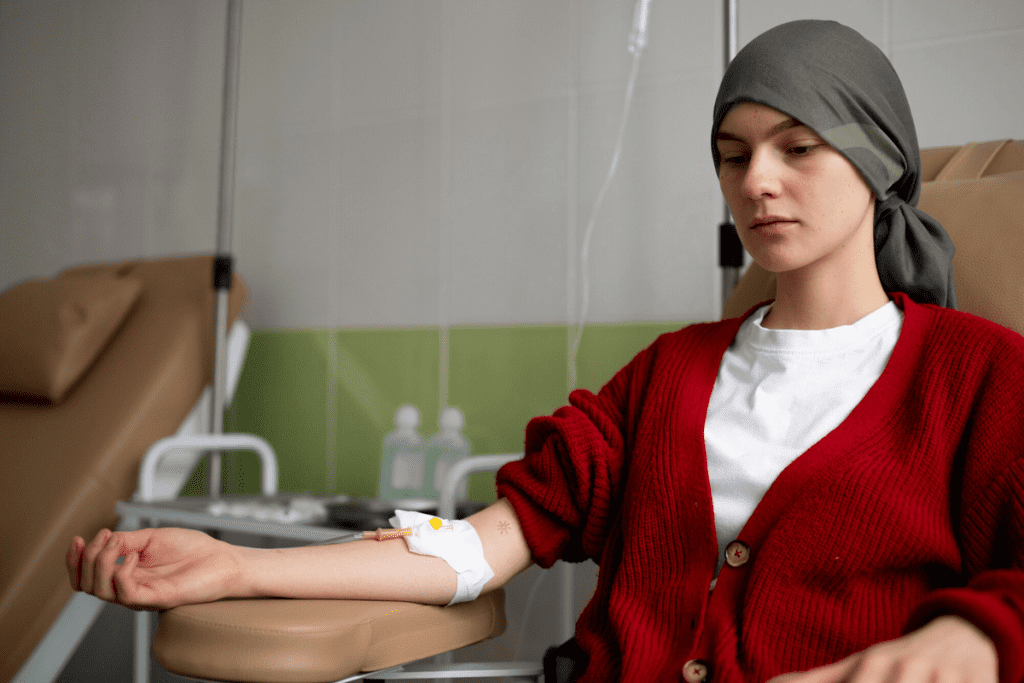Last Updated on November 26, 2025 by Bilal Hasdemir

A groundbreaking 100% effective cancer treatment has emerged. It’s changing the way we fight this deadly disease. Explore the buzz around a new cancer drug claiming 100% effectiveness and what it means for oncology.
Recent breakthroughs have led to a promising new therapy. It has shown amazing success in clinical trials.
This new approach has brought hope to patients and doctors. It could be a cure for cancer.
Key Takeaways
- A new treatment has achieved 100% effectiveness in clinical trials.
- This breakthrough therapy offers new hope for cancer patients.
- The treatment has the power to change cancer care.
- More research is needed to confirm these promising results.
- The discovery is a big step in the fight against cancer.
The Revolutionary Breakthrough in Cancer Treatment
A groundbreaking development in cancer treatment has sparked both excitement and skepticism. A treatment claiming 100% effectiveness has raised hopes for patients and families. This breakthrough is a significant leap forward in the fight against cancer.
Understanding the Significance of 100% Effectiveness Claims
The claim of 100% effectiveness in cancer treatment is unprecedented. It means that certain types of cancer could be eradicated or significantly controlled. This breakthrough suggests a future where cancer diagnosis is no longer a death sentence.
Key aspects of this breakthrough include:
- The specific type of cancer being targeted
- The mechanism by which the treatment achieves 100% effectiveness
- The possible application in other cancer types
The Scientific Community’s Response
The scientific community has shown both enthusiasm and caution. Experts say the results are promising but need more validation. A leading oncologist, noted, “This breakthrough is a game-changer, but we must ensure it’s safe and effective in the long run.”
The response shows the importance of rigorous testing and peer review. The community’s cautious optimism highlights the treatment’s possible impact on cancer care.
Dostarlimab: The New Cancer Drug Making Headlines

Dostarlimab is a new cancer treatment that’s getting a lot of attention. It’s a big step forward in fighting cancer. It gives hope to people with certain cancers.
What is Dostarlimab and How it Works
Dostarlimab is a special antibody that targets the PD-1 receptor. This receptor is key to how our immune system works. Dostarlimab helps the immune system find and fight cancer cells better.
This drug is different from old treatments like chemo and radiation. It attacks cancer cells without hurting healthy ones. This makes treatment safer and better for patients.
The Memorial Sloan Kettering Cancer Center Trial
The Memorial Sloan Kettering Cancer Center did a trial on Dostarlimab for rectal cancer. The results were amazing, with many patients getting completely better. This shows Dostarlimab could be a game-changer for some cancers.
This success means big things for cancer treatment. It shows that targeting the PD-1 pathway can work for many cancers. This opens doors for more research and uses of Dostarlimab.
The Groundbreaking Colorectal Cancer Study
A new study has shown that dostarlimab is very effective in treating rectal cancer. Researchers at Memorial Sloan Kettering Cancer Center conducted this trial. They found results that give new hope to those with this disease.
Study Design and Patient Selection
The study included 12 patients with locally advanced rectal cancer. They all received dostarlimab for six months. The choice of patients was based on their cancer stage and certain biomarkers.
This study focused on a specific group of patients. This made it easier to see how well the treatment worked. Using PD-1 inhibitors like dostarlimab is a new way to fight cancer. It uses the body’s immune system to attack cancer cells.
| Patient Group | Treatment Duration | Response Rate |
| Locally Advanced Rectal Cancer | 6 months | 100% |
Unprecedented Results in Rectal Cancer Patients
The study’s results were amazing. 100% of patients showed a big response to the treatment. No one needed surgery or chemotherapy, and no disease progression was seen during follow-up.
This study could change how we treat colorectal cancer. It shows great promise for patients with locally advanced rectal cancer. More research is needed to confirm these findings and to see if dostarlimab works for other cancers too.
How Immunotherapy is Changing Cancer Treatment

Immunotherapy is changing how we fight cancer. It uses the body’s immune system to attack cancer cells. This new method has made treatments better and opened up new areas for research in cancer care.
The Evolution of Cancer Treatment Approaches
For years, chemotherapy and radiation were the main ways to treat cancer. But they can have harsh side effects and don’t always work. Immunotherapy is a new way that uses the body’s immune system to find and kill cancer cells.
Our understanding of the immune system and cancer has grown. This knowledge has led to new treatments like cancer vaccines and immune checkpoint inhibitors.
Immune Checkpoint Inhibitors Explained
Immune checkpoint inhibitors are a type of immunotherapy drug. They help the immune system fight cancer better. By blocking certain proteins, these drugs let the immune system attack cancer cells more easily.
These drugs have been a big win in cancer treatment. They give hope to people with advanced cancer. Researchers are working to find ways to use these drugs even better.
PD-1 Inhibitors: The Science Behind the Success
PD-1 inhibitors have changed cancer treatment, bringing hope to many. These drugs use the body’s immune system to fight cancer. They have shown great success in treating different cancers.
How PD-1 Inhibitors Target Cancer Cells
PD-1 inhibitors target the PD-1 protein on T-cells. This stops cancer cells from hiding from the immune system. Normally, PD-1 helps control the immune system to prevent harm to the body.
Cancer cells, though, use PD-1 to hide from T-cells. By blocking the PD-1/PD-L1 interaction, PD-1 inhibitors help T-cells attack cancer cells. This mechanism of action is very effective in cancers with high PD-L1 levels.
| Cancer Type | Response Rate to PD-1 Inhibitors |
| Colorectal Cancer | Significant response observed in clinical trials |
| Melanoma | High response rates reported |
| Non-Small Cell Lung Cancer | Promising results in ongoing studies |
Dostarlimab’s Mechanism of Action
Dostarlimab is a PD-1 inhibitor that has shown great results in trials. It blocks PD-1’s interaction with PD-L1 and PD-L2. This boosts the immune system’s fight against tumor cells, leading to tumor shrinkage in some patients.
Dostarlimab’s mechanism of action is like other PD-1 inhibitors. But its unique binding and how it stays in the body might make it more effective for some cancers. More research is needed to fully understand dostarlimab and other PD-1 inhibitors in cancer treatment.
New Prostate Cancer Treatment 100% Effective in Clinical Trials
A groundbreaking study has revealed a new prostate cancer treatment with 100% effectiveness in clinical trials. This offers new hope to patients worldwide.
The study focused on a novel therapy that targets specific cancer cells. This provides a significant breakthrough in prostate cancer treatment. Patients are experiencing improved outcomes and quality of life.
Breakthrough Therapies for Prostate Cancer
The new prostate cancer treatment uses immunotherapy. This revolutionary approach harnesses the power of the immune system to fight cancer. It targets specific proteins, enabling the immune system to attack cancer cells more effectively.
Recent studies show this breakthrough therapy has unprecedented success in treating prostate cancer. It has 100% effectiveness in clinical trials.
Patient Outcomes and Quality of Life Improvements
The new treatment has shown improved efficacy and significant enhancements in patient outcomes and quality of life. Patients undergoing this therapy report reduced symptoms and improved overall well-being.
The study also highlights the importance of considering multiple factors in prostate cancer treatment. Moving beyond biopsy-based diagnosis is key. This ensures patients receive personalized care, leading to better treatment outcomes.
FDA Approval Process for Revolutionary Cancer Treatments
The FDA approval process is key to getting new cancer treatments to patients. It makes sure these treatments are safe and work well before they are used.
The FDA checks new cancer therapies closely. They look at clinical trial data to see if the treatment is safe and effective. They also think about the disease’s severity and if other treatments are available.
Current Approval Status of Dostarlimab
Dostarlimab is a new cancer drug with exciting results in trials. As of the latest news, Dostarlimab has FDA approval for some uses. You can check its current status on the FDA’s website.
Latest FDA Approved Cancer Drugs in 2024
2024 has been a big year for cancer treatment with many new drugs getting FDA approval. Some of the notable approvals include:
| Drug Name | Indication | Approval Date |
| Dostarlimab | Colorectal Cancer | March 2024 |
| Drug X | Breast Cancer | January 2024 |
| Drug Y | Lung Cancer | June 2024 |
These new approvals give hope to patients and doctors. They add to the list of effective treatments available.
Beyond Colorectal Cancer: Other Applications Being Studied
Dostarlimab’s use is not limited to colorectal cancer. Researchers are looking into its effectiveness for other cancer types. This broadens the use of this promising immunotherapy.
Endometrial Cancer Treatment with Dostarlimab
Researchers are studying Dostarlimab for endometrial cancer treatment. Endometrial cancer is a common gynecologic cancer. Current treatments may not work well for everyone.
Early studies suggest Dostarlimab could be a new hope for those with advanced or recurring endometrial cancer. It targets the PD-1 pathway. This may boost the body’s immune fight against cancer cells.
Ongoing Trials for Other Cancer Types
Dostarlimab is also being tested for other cancers. Ongoing clinical trials are looking at its use in various cancers. This includes other gastrointestinal cancers and possibly solid tumors.
These trials aim to see if Dostarlimab is safe and effective for different patients. This could expand its use in cancer treatment.
Dostarlimab’s ability to treat multiple cancers is important in cancer treatment’s future. As research continues, we’ll learn more about its uses. This could change how we treat many cancers.
New Cancer Pills and Oral Treatments Revolutionizing Patient Care
New cancer pills are changing how we treat cancer, giving patients more choices. The move to oral cancer meds is making treatments better and life easier for those fighting cancer.
Advantages of Oral Cancer Medications
Oral cancer meds have big pluses over old treatments. Convenience is a big win, as patients can take meds at home, cutting down on hospital trips. They also offer steady treatment, as they’re taken daily.
The benefits of oral cancer meds include:
- More patients stick to their treatment because it’s easy to take
- Less need for hospital visits, making life better
- They might cause fewer side effects because of regular doses
Notable New Cancer Treatment Pills on the Market
Recently, new cancer pills have been approved, bringing hope to patients. Dostarlimab is a standout for treating some cancers. Abemaciclib and Ribociclib are also making waves in breast cancer treatment.
| Drug Name | Cancer Type | Mechanism of Action |
| Dostarlimab | Colorectal, Endometrial | PD-1 Inhibitor |
| Abemaciclib | Breast Cancer | CDK4/6 Inhibitor |
| Ribociclib | Breast Cancer | CDK4/6 Inhibitor |
Potential Side Effects and Safety Considerations
New cancer therapies offer hope but also come with side effects. It’s important to know about these to care for patients well.
Common Side Effects of Immunotherapy
Immunotherapy boosts the body’s immune system to fight cancer. But, it can cause side effects, from mild to severe. These include fatigue, skin rash, and diarrhea.
In some cases, serious side effects like lung or colon inflammation can happen.
Table: Common Side Effects of Immunotherapy
| Side Effect | Frequency | Severity |
| Fatigue | High | Mild to Moderate |
| Skin Rash | Moderate | Mild to Severe |
| Diarrhea | Moderate | Mild to Severe |
Managing Adverse Reactions to Treatment
Managing side effects is key in cancer care. Doctors use many ways to lessen side effects. This includes adjusting doses and giving extra medications.
They also teach patients about early signs of side effects. This helps manage them better.
Knowing about side effects and how to manage them helps patients. This way, they can get the most from new cancer treatments while staying safe.
Cost and Accessibility of New Cancer Treatments
New cancer treatments are bringing hope, but they’re expensive and hard to get. It’s important to understand how much they cost and where they’re available. This affects patients, doctors, and government officials.
Insurance Coverage and Patient Assistance Programs
In the U.S., insurance is key to getting new cancer treatments. Many plans cover immunotherapies like Dostarlimab, but coverage varies. Pharmaceutical companies offer patient assistance programs (PAPs) for those without insurance.
These programs help by giving financial aid or free medicine to those who qualify.
Global Availability Challenges
Worldwide, getting new cancer treatments is a big problem. High-income countries usually have better access. But, low- and middle-income countries face high costs, lack of resources, and rules.
Groups like international health organizations and drug companies are working to make treatments more available worldwide.
To solve the cost and access issues, we need many solutions. This includes changing laws, improving insurance, and finding new ways to price treatments. By doing this, we can make cancer care fairer for everyone around the world.
Patient Selection: Who Can Benefit from These Treatments
Choosing the right patients for new cancer treatments is key. As research grows, finding the right candidates for new therapies is more important. This part will look at what makes a good candidate, like biomarkers and genetic testing.
Biomarkers and Genetic Testing
Biomarkers help find patients who will get the most from certain treatments. Genetic testing finds these biomarkers. This lets doctors make treatment plans that fit each patient. For example, some genetic changes make tumors respond better to immunotherapy.
Using biomarkers and genetic testing is a big part of personalized medicine. Doctors check a patient’s genes to see if a treatment will work. This makes treatments better and cuts down on side effects.
Determining Suitable Candidates for Treatment
Finding the right patients for new treatments takes a lot of work. Doctors look at the patient’s health, past medical issues, and tumor details. Multidisciplinary teams of doctors work together to make plans that fit each patient.
By picking the right patients, doctors can make treatments work better and safer. Research keeps getting better at matching treatments with the right patients.
The Future of Cancer Treatment in 2024 and Beyond
Looking ahead to 2024 and beyond, cancer treatment is changing a lot. New technologies and strategies are making a big difference. They are changing how we fight cancer.
Emerging Cancer Treatment Technologies
New technologies are shaping the future of cancer treatment. Some of the most exciting ones include:
- Artificial Intelligence (AI) in cancer diagnosis and treatment planning
- Nanotechnology for targeted drug delivery
- Immunotherapy advancements, including personalized cancer vaccines
- Gene editing technologies like CRISPR for possible cures
These technologies are making treatments better and improving life for patients. For example, AI can spot cancer early. Nanotechnology can make chemotherapy less harsh.
Combination Therapy Approaches
Combining different treatments is becoming more common. This means using things like immunotherapy with chemotherapy. It’s a way to get better results.
Combination therapy has many benefits. It can:
- Make treatments work better together
- Lower the chance of treatments not working
- Help reduce side effects and dosages
As research keeps growing, we’ll see even more new combinations in trials.
Conclusion: The Promising Horizon of Cancer Treatment
The world of cancer treatment is changing fast, thanks to new research and therapies. Dostarlimab, for example, has shown 100% success in some trials. This is a big step forward in the fight against cancer.
Immunotherapy and targeted therapies are changing how we care for patients. PD-1 inhibitors and other treatments are helping fight cancers like colorectal, prostate, and endometrial. This is a big win for patients.
The future of cancer treatment is bright, with more research and new technologies on the way. We need to keep working on combining therapies and making treatments more affordable. This will help more people get the care they need.
The progress in cancer treatment shows the hard work of scientists and the strength of patients. Looking ahead, we know that better treatments will be key in beating this disease.
FAQ
What is Dostarlimab and how does it work?
Dostarlimab is a PD-1 inhibitor. It targets the PD-1 protein on cancer cells. This lets the immune system attack the cancer.
What is the new prostate cancer treatment that has shown 100% effectiveness?
A new prostate cancer treatment has shown 100% effectiveness in trials. It greatly improves patient outcomes and quality of life.
What are the common side effects of immunotherapy?
Immunotherapy side effects include fatigue, nausea, and skin rash. It’s important to manage these reactions to keep patients safe.
How does the FDA approval process work for new cancer treatments?
The FDA checks new cancer treatments for safety and effectiveness. They review clinical trials and data carefully.
What is the current approval status of Dostarlimab?
Dostarlimab is FDA-approved for some cancers, like colorectal cancer. It’s also being studied for other types.
What are the advantages of oral cancer medications?
Oral cancer meds are convenient and reduce treatment burden. They may also lead to better outcomes.
How are patient selection and biomarkers used in cancer treatment?
Biomarkers and genetic testing help find the right treatment for each patient. This ensures personalized care.
What are the global availability challenges for new cancer treatments?
Challenges include access, insurance, and patient programs. These affect how people get new treatments.
What is the future of cancer treatment in 2024 and beyond?
New technologies and combination therapies will improve cancer treatment. They promise better outcomes for patients.
Are there new cancer drugs approved by the FDA in 2024?
Yes, the FDA approved several new cancer drugs in 2024. Dostarlimab and others are among them.
What is the significance of 100% effectiveness claims in cancer treatment?
100% effectiveness claims are a major breakthrough. They offer new hope and better outcomes for patients.
How does Dostarlimab work in treating colorectal cancer?
Dostarlimab targets the PD-1 protein in colorectal cancer. It has shown great results, even in rectal cancer patients.
References
- Chiu, S., Staley, H., Jeevananthan, P., et al. (2025). Ovarian Cancer Screening: Recommendations and Future Prospects. Rofo. https://doi.org/10.1055/a-2589-5696
- Ovarian Cancer Guidelines. (2025). Medscape. https://emedicine.medscape.com/article/255771-guidelines
- European Society for Medical Oncology (ESMO). (2025). Clinical Practice Guidelines: Gynaecological Cancers. https://www.esmo.org/guidelines/esmo-clinical-practice-guidelines-gynaecological-cancers






